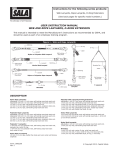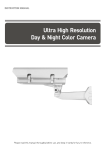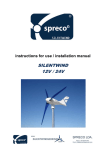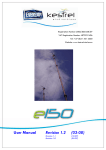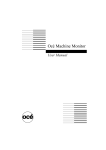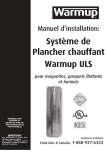Download User Instruction Manual Web and Rope Lanyards, D
Transcript
Instructions for the following series products: Web Lanyards Rope Lanyards D-Ring Extensions (See back pages for specific model numbers.) User Instruction Manual Web and Rope Lanyards, D-Ring Extension This manual is intended to meet the Manufaturer’s Instructions as recommended by OSHA, and should be used as part of an employee training program. Figure 1 - Web and Rope Lanyards DESCRIPTION Nylon Rope Lanyards: Adjustable 1/2 inch rope, self locking snap hook each end. Adjustable 5/8 inch rope, self locking snap hook each end. 1/2 inch rope, self locking snap each end. 1/2 inch rope, self locking snap hook, carabiner other end. 5/8 inch rope, self locking snap hook each end. Polyester Web Lanyards/D-Ring Extension: Adjustable 1 inch web, self locking snap hook each end. 1 inch web, self locking snap hook each end. 1 inch web, self locking hook, D-ring (D-ring extension). 1 inch web, self locking snap hook, carabiner other end. 1 inch web, self locking snap hook, closed loop choker. Polyester Rope Lanyards: Adjustable 1/2 inch rope, self locking snap hook each end. Adjustable 5/8 inch rope, self locking snap hook each end. 1/2 inch rope, self locking snap hook each end. 1/2 inch rope, self locking snap hook, carabiner other end. 5/8 inch rope, self locking snap hook each end. Kevlar Web Lanyards: 1-3/4 inch Kevlar web, self locking snap hook each end. 1-3/4 inch Kevlar web, self locking snap hook, 1-3/16 inch throat carabiner. Nylon Web Lanyards: Adjustable 1 inch web, self locking snap hook each end. 1 inch web, self locking snap hook each end. Polyester Y-Lanyards: 1-3/4 inch polyester web, self locking snap hook each end, spreader bar, center D-ring. 1-3/4 inch polyester web, self locking snap hook each end, center D-ring. Wristlets: 1 inch web, center O-ring, wrist loop each end. 1 inch web, Y style, center D-ring, wrist loop each end. 1 inch web, Detachable style, O-ring, 1 wrist loop. 1 © Copyright 2005, DB Industries, Inc. WARNING: This product is part of a personal restraint, work positioning, suspension, or rescue system. The user must read and follow the manufacturer's instructions for each component or part of the complete system. These instructions must be provided to the user of this equipment. The user must read and understand these instructions or have them explained to them before using this equipment. Manufacturer's instructions must be followed for proper use and maintenance of this product. Alterations or misuse of this product or failure to follow instructions may result in serious injury or death. IMPORTANT: If you have questions on the use, care, application, or suitability for use of this equipment, contact DBI/SALA. IMPORTANT: Before using this equipment record the product identification information (found on the I.D. label) in the inspection maintenance log in section 9.0 of this manual. 1.0 1.1 APPLICATION Figure 2 - Applications PURPOSE: DBI/SALA lanyards are to be used as part of a personal restraint, work positioning, suspension, or rescue system. The D-ring extension assembly may also be used as part of a personal fall arrest system only if it is attached to a self retracting lifeline or an energy absorbing lanyard. Applications include: inspection work, construction, demolition, maintenance, oil production, and confined space rescue. See Figure 2. A. RESTRAINT: The lanyard is used to prevent the user from reaching a hazard, such as leading edge work. No vertical free fall possible. NOTE: The fall arrest application is for the D-ring extension only. B. WORK POSITIONING: The lanyard is used to position or support (with a harness or body belt) the user at the work position, such as window washing or steel workers. Two feet maximum free fall. C. SUSPENSION: The lanyard (generally a Y-type) is used with a chair or other support system to suspend or transport the user vertically, such as in a boatswain’s chair. No vertical free fall possible. D. RESCUE: The lanyard (generally a Y-type or wristlet) is used to retrieve a victim in a rescue, such as confined space rescue and retrieval. No vertical free fall possible. E. FALL ARREST: The D-ring extension is used in-line wih a personal fall arrest system to assist in attachment to the system. 1.2 LIMITATIONS: The following application limitations must be recognized and considered before using this product: A. CAPACITY: This equipment is for use by persons with a combined weight (person, clothing, tools, etc.) of no more than 310 lbs. B. FREE FALL: Lanyards used for work positioning applications must be rigged to minimize any potential vertical free fall. In no case should the potential free fall be greater than two feet. For situations where the free fall may exceed two feet, a backup fall arrest system should be used. The Y-lanyards and wristlets may only be used where there is no possible vertical free fall. 2 If the D-ring extension assemblies are used in conjunction with a self retracting lifeline or an energy absorbing lanyard in a fall arrest application, the length of the D-ring extension assembly must be taken into account when calculating the free fall distance and the fall clearance requirements. C. FALL CLEARANCE: Ensure that enough clearance exists in your fall path to prevent striking an object. The amount of clearance needed is dependent on the type and length of the lanyard used and anchorage location. See section 1.2 B. D. BACKUP FALL ARREST SYSTEM: Some applications of this equipment may require the use of a backup fall arrest system; such as when using a Y-lanyard to suspend a person in a boatswain’s chair. E. PHYSICAL AND ENVIRONMENTAL HAZARDS: Use of this equipment in areas with physical or environmental hazards may require additional precautions to reduce the possibility of injury to the user or damage to the equipment. Hazards may include, but are not limited to; heat, chemicals, corrosive environments, high voltage power lines, gases, moving machinery, and sharp edges. Contact DBI/SALA if you have any questions about using this equipment where physical or environmental hazards exists. F. TRAINING: This equipment must be used by persons who have been properly trained in its correct application and use. 1.3 2.0 Refer to applicable local, state, and federal (OSHA) requirements governing this equipment for more information on lanyards and associated system components. SYSTEM REQUIREMENTS 2.1 COMPATIBILITY OF COMPONENTS: DBI/SALA equipment is designed for use with DBI/SALA approved components and subsystems only. Substitutions or replacements made with non-approved components or subsystems may jeopardize compatibility of equipment and may effect the safety and reliability of the complete system. 2.2 COMPATIBILITY OF CONNECTORS: Connectors are considered to be compatible with connecting elements when they have been designed to work together in such a way that their sizes and shapes do not cause their gate mechanisms to inadvertently open regardless of how they become oriented. Contact DBI/SALA if you have any questions about compatibility. Connectors (hooks, carabiners, and D-rings) must be capable of supporting at least 5,000 lbs. (22.2 kN). Connectors must be compatible with the anchorage or other system components. Do not use equipment that is not compatible. Non-compatible connectors may unintentionally disengage. See Figure 3. Connectors must be compatible in size, shape, and strength. Self locking snap hooks and carabiners are required by ANSI Z359.1 and OSHA. 2.3 MAKING CONNECTIONS: Only use self-locking snap hooks and carabiners with this equipment. Only use connectors that are suitable to each application. Ensure all connections are compatible in size, shape and strength. Do not use equipment that is not compatible. Ensure all connectors are fully closed and locked. DBI/SALA connectors (snap hooks and carabiners) are designed to be used only as specified in each product’s user’s instructions. See Figure 4 for inappropriate connections. DBI/SALA snap hooks and carabiners should not be connected: A. To a D-ring to which another connector is attached. B. In a manner that would result in a load on the gate. NOTE: Large throat opening snap hooks should not be connected to standard size D-rings or similar objects which will result in a load on the gate if the hook or D-ring twists or rotates. Large throat snap hooks are designed for use on fixed structural elements such as rebar or cross members that are not shaped in a way that can capture the gate of the hook. C. In a false engagement, where features that protrude from the snap hook or carabiner catch on the anchor and without visual confirmation seems to be fully engaged to the anchor point. 3 Figure 3 - Unintentional Disengagement (Roll-out) If the connecting element that a snap hook (shown) or carabiner attaches to is undersized or irregular in shape, a situation could occur where the connecting element applies a force to the gate of the snap hook or carabiner. This force may cause the gate (of either a self-locking or a non-locking snap hook) to open, allowing the snap hook or carabiner to disengage from the connecting point. Small ring or other non-compatibly shaped element 1. Force is applied to the snap hook. 2. The gate presses against the connecting ring. 3. The gate opens allowing the snap hook to slip off. D. To each other. E. Directly to webbing or rope lanyard or tieback (unless the manufacturer’s instructions for both the lanyard and connector specifically allow such a connection). F. 2.4 Figure 4 - Inappropriate Connections To any object which is shaped or dimensioned such that the snap hook or carabiner will not close and lock, or that roll-out could occur. ANCHORAGE STRENGTH: The anchorage strength required is dependent on the application type. The following are guidelines for some application types: A. RESTRAINT: Anchorages must support a minimum of 3,000 lbs. per person attached. B. WORKING POSITIONING: Anchorages must support at least 3,000 lbs. per person attached; or be designed, installed, and used under the supervision of a qualified person as part of a complete system, maintaining a safety factor of at least two. C. SUSPENSION: Anchorages must support a minimum of 2,500 lbs. per person attached. D. RESCUE: Anchorages must support a minimum of 2,500 lbs. per person attached. 4 WARNING: Anchorages used for restraint, rescue, or suspension may only be used where there is no possible vertical free fall. These anchorages do not have sufficient strength for work positioning or fall arrest. Do not connect work positioning or fall arrest systems to these anchorages. Anchorages intended for work positioning may not be suitable for use for use for fall arrest systems (fall greater than two feet) and should not be used for fall arrest unless specifically designed to do so. 3.0 Figure 5 - Hook Operation OPERATION AND USAGE WARNING: Do not alter or intentionally misuse this equipment. Consult DBI/SALA when using this equipment in combination with components or subsystems other than those described in this manual. Some subsystem and component combinations may interfere with the operation of this equipment. Use caution when using this equipment around moving machinery, electrical hazards, chemical hazards, and sharp edges. WARNING: Consult your doctor if there is reason to doubt your fitness to safely absorb the shock from a fall arrest. Age and fitness seriously affect a worker's ability to withstand falls. Pregnant women and minors must not use this equipment. 3.1 BEFORE EACH USE of this equipment, carefully inspect it to assure that it is in serviceable condition. Check for worn or damaged parts. Ensure that all hardware is present and secure. Inspect for sharp edges, burrs, cracks, or corrosion. Ensure self locking snap Figure 6 - Anchorage hooks or carabiners work properly. See Figure 5. Inspect the rope or webbing for wear, cuts, burns, frayed edges, breaks, or other damage. Refer to section 5.0 for further inspection details. Do not use if inspection reveals an unsafe condition. 3.2 PLAN your restraint, working positioning, suspension, or rescue system before starting your work. Consider all factors that affect your safety at any time during use. The following list gives some important points to consider when planing your system. A. ANCHORAGE: Select a rigid anchorage point that is capable of supporting the required loads. See section 2.4. For work positioning systems, the anchorage location must be selected to limit the free fall to two feet, to reduce swing fall hazards, and to avoid striking an object during a fall. See Figures 6 and 7. B. FREE FALL: Depending on the lanyard type and the application, the allowable free fall ranges from no free fall to two feet. See section 1.2.B. C. FALL CLEARANCE: Should a fall occur, there must be sufficient clearance in the fall area to arrest the fall before striking the ground or other objects. D. BACKUP FALL ARREST: Some suspension and work positioning applications of this equipment may require a backup fall arrest system and independent fall arrest anchorage. See OSHA guidelines when designing the system. 5 Figure 7 - Swing Fall E. SHARP EDGES: Avoid working where the lanyard, subsystem, or other system components will be in contact with, or abrade against unprotected sharp edges. Do not loop the lanyard around small diameter structural members. If working with this equipment near sharp edges is unavoidable, protection against cutting must be provided by using a heavy pad or other means over the exposed sharp edge. F. RESCUE: Should a fall occur, the user (employer) must have a rescue plan and the means at hand to implement it. G. AFTER A FALL: Any equipment which has been subjected to the forces of arresting a fall must be removed from service immediately and destroyed or contact a factory authorized service center for repair. WARNING: Follow the manufacturer’s instructions for associated equipment (full body harness, workseat, etc.) used in your restraint, work positioning, suspension, or rescue system. IMPORTANT: For special (custom) versions of this product, follow the instructions herein. If included, see supplement for additional instructions. 3.3 MAKING CONNECTIONS: Do not use hooks or connectors that will not completely close over the attachment object. For these situations, use a “tie-off” adapter or other anchorage connector to allow a compatible connection. Do not knot a lanyard in any manner. Do not attach a snap hook directly to a horizontal lifeline or to a webbing loop. Lanyards with web loops must only be attached to other components with compatible connections. When a web lanyard is used as a D-ring extension on a harness, connect the snap hook to the dorsal connector on the back of the harness. Always follow the manufacturer’s instructions supplied with each system component. A. CONNECTING TO ANCHORAGE OR ANCHORAGE CONNECTOR: When using a lanyard connect one end of the lanyard to the full body harness. Connect other end of the lanyard to the anchorage or anchorage connector. Ensure the connector (self locking snap hook or carabiner) is fully engaged and locked onto the body support connecting point and anchorage or anchorage connector. See Figure 5 for operation of hooks. Ensure connections are compatible in size, shape, and strength. See the manufacturer’s instructions for the anchorage for more information on making connections. B. CONNECTING TO THE BODY SUPPORT: For general restraint, connect the lanyard to the dorsal D-ring between the shoulders on a full body harness. If using a body belt connect the lanyard to the D-ring and position the belt so the D-ring is located on your back side. For positioning applications connect the lanyard to the side D-rings or the front D-ring on the full body harness or body belt. Some full body harnesses incorporate shoulder D-rings. A Y-lanyard may be connected to these for Figure 8 - Web Loop Connection rescue and suspension applications. Ensure the connections are compatible in size, shape, and strength. See the body support manufacturer’s instructions for more information on making connections. Attaching a Lanyard with Web Loops: See Figure 8. 1. Insert the energy absorbing lanyard web loop through the harness web loop or the D-ring. 2. Insert the opposite end of the energy absorbing lanyard through the connecting web loop. 3. Pull the attached energy absorbing lanyard through the connecting web loop to secure it. WARNING: Only compatible connections may be made with the connecting loops. Use of snap hooks (self locking and non-locking types) may result in inadvertent disengagement from the web loops. Failure to follow these instructions may result in serious injury or death. C. CONNECTING TO A ROPE GRAB: For restraint or work positioning applications only. When connecting a lanyard to a rope grab connect one end to the attachment point of the rope grab and connect the other end to the body support. Some rope grabs may be supplied with a permanently attached lanyard or an energy absorbing lanyard. For these cases, use of an additional lanyard connected between the rope grab and the 6 body support is not recommended. In all cases, ensure that the length of the lanyard does not exceed the rope grab manufacturer’s recommended maximum connection length. Ensure the connections are compatible in size, shape, and strength. See the rope grab manufacturer’s instructions for more information. D. CONNECTING TO SELF RETRACTING LIFELINE: For restraint applications only. DBI/SALA does not recommend connecting a lanyard to a self retracting lifeline. Special applications exist where it may be permissible. E. CONNECTING TO THE WRISTLET: For emergency rescue use only. The wristlets provide a limited support and should only be used when other emergency rescue devices are impractical. Consult a qualified medical personnel before using the wristlet. To use, place at wrist location. Locate wrist between the web strap and the pad. Pull the web tight to secure the wrist. Make certain the wrist is securely captivated and the wristlet will not slide or release. F. CONNECTING TO THE D-RING EXTENSION ASSEMBLY: The D-ring extension assembly may be attached to a self retracting lifeline or an energy absorbing lanyard for fall arrest applications only. The D-ring extension snap hook should be connected to the dorsal D-ring on the full body harness. The D-ring on the extension assembly is used for attachment of the snap hook on the self retracting lifeline or the energy absorbing lanyard. Ensure the connections are compatible in size, shape, and strength. See the body support, self retracting lifeline, and energy absorbing lanyard manufacturer’s instructions for more information on making connections. 3.4 4.0 4.1 After use return the lanyard for cleaning or storage as described in section 6.0. TRAINING It is the responsibility of all users of this equipment to understand these instructions, and to be trained in the correct installation, use, and maintenance of this equipment. These individuals must be aware of the consequences of improper installation or use of this equipment. This user manual is not a substitute for a comprehensive training program. Training must be provided on a periodic basis to ensure proficiency of the users. IMPORTANT: Training must be conducted without exposing the trainee to a fall hazard. Training should be repeated periodically. 5.0 5.1 INSPECTION FREQUENCY: • Before each use visually inspect per steps listed in section 5.2 and 5.3 • The lanyard must be inspected by a competent person other than the user at least annually. See section 5.2 and 5.3 for guidelines. Record the results of each inspection in the inspection log found in section 9.0. IMPORTANT: If this equipment has been subjected to forces resulting from the arrest of a fall, it must be immediately removed from service and destroyed or returned to DBI/SALA for possible repair. See section 5.2. IMPORTANT: Extreme working conditions (harsh environment, prolonged use, etc.) may require increasing the frequency of inspections. 5.2 INSPECTION STEPS: Step 1. Inspect the lanyard hardware (snap hooks, adjusters, thimbles, spreader bar, etc.). These items must not be damaged, broken, distorted, or have any sharp edges, burrs, cracks, worn parts, or corrosion. Ensure the connecting hooks work properly. The hook gates must move freely and lock upon closing. Ensure the adjusters, if present, work properly. Step 2. Inspect the lanyard per the following as applicable: WEBBING AND STITCHING: Inspect the webbing. The material must be free of frayed, cut, or broken fibers. Check for tears, abrasions, mold, burns, or discoloration. Inspect the stitching. Check for pulled or cut stitches. The webbing must be free of knots, excessive soiling, heavy paint buildup, and rust 7 staining. Check for chemical or heat damage, indicated by brown, discolored, or brittle areas. Check for ultraviolet damage, indicated by discoloration and the presence of splinters or slivers on the webbing surface. All of these above factors are known to reduce the webbing strength. Damaged or questionable webbing should be replaced. SYNTHETIC ROPE: Inspect the rope for concentrated wear. The material must be free of frayed or broken strands, cuts, abrasions, burns, and discoloration. The rope must be free of knots, excessive soiling, heavy paint buildup, and rust staining. Rope splices must be tight, with five (5) full tucks, and the thimbles must be held by the splice. Check for chemical or heat damage indicated by brown, discolored, or brittle areas. Check for ultraviolet damage, indicated by discoloration and the presence of splinters and slivers on the rope surface. All of the above factors are known to reduce the rope strength. Damaged or questionable ropes should be replaced. 5.3 Step 3. Inspect the labels. All labels must be present and fully legible. See section 8.0. Step 4. Inspect each system component or subsystem according to the associated manufacturer’s instructions. Step 5. Record the inspection date and results on the inspection log. See section 9.0. If inspection reveals a defective condition, remove the unit from service immediately and destroy, or contact a factory authorized service center for repair. IMPORTANT: Only DBI/SALA or parties authorized in writing may make repairs to this equipment. 6.0 MAINTENANCE - SERVICING - STORAGE 6.1 Clean the lanyard with water and a mild detergent solution. Wipe the hardware off with a clean, dry cloth, and hang it to air dry. Do not force dry with heat. If you have any questions regarding the cleaning of this equipment, or require more information contact DBI/SALA. An excessive buildup of dirt, paint, etc., may prevent the lanyard from working properly, and in severe cases degrade the webbing or rope to a point where it has become weakened and should be removed from service. If you have any questions concerning the condition of your lanyard, or have any doubt about putting it into service, contact DBI/SALA. 6.2 Additional maintenance and servicing procedures (i.e. replacement parts) must be completed by a factory authorized service center. Authorization must be in writing. 6.3 Store the lanyard in a cool, dry, clean environment out of direct sunlight. Avoid areas where chemical vapors may exist. Thoroughly inspect the lanyard after extended storage. 7.0 SPECIFICATIONS • Meets OSHA requirements. • U.S. Patent Number 4,977,647 (9503175 snap hook) • Canadian Patent Number 2,027,787 (9503175 snap hook) 8 Rope Type Nylon Polyester Web Type Nylon Polyester Ployester Lanyard Material Length 1/2 inch diameter, 5,750 lbs. tensil strength, or 5/8 inch diameter, 9,350 lbs. tensil strength, three strand nylon rope Fixed Adjustable 1/2 inch diameter, 5,750 lbs. tensil strength, or 5/8 inch diameter, 9,000 lbs. tensil strenth, three strand polyester rope Fixed Adjustable Lanyard Material Length 1 inch wide adjustable, 9,000 lbs. tensil strength, or 1 inch wide fixed, 7,500 lbs. tensil strength, latex treated nylon web Fixed Adjustable 1 inch polyester webbing, 9,800 lbs. tensil strength Fixed Adjustable 1 3/4 inch ployester webbing, 8,800 lbs. tensil strength Fixed 9 Hardware Drop forged alloy steel self locking snap hook with 5,000 lbs. tensil strength. Steel self closing/locking carabiner with 5,000 lbs. tensil strength. Hardware Drop forged alloy steel self locking snap hook with 5,000 lbs. tensil strength. Steel self closing/locking carabiner with 5,000 lbs. tensil strength. Drop forged alloy steel link, (adjustable models only), drop forged steel D-ring with 5,000 lbs. tensil strength. Drop forged alloy steel self locking snap hook and D-ring with 5,000 lbs. tensil strength. Aluminum spreader bar (Y-Lanyards only), covered with nylon tubular webbing. 8.0 8.1 LABELING These labels must be present and fully legible: 10 9.0 INSPECTION AND MAINTENANCE LOG DATE OF MANUFACTURE: _______________________________________________________________________ MODEL NUMBER: ______________________________________________________________________________ DATE PURCHASED: ________________________________________________________________________________ INSPECTION DATE INSPECTION ITEMS NOTED CORRECTIVE ACTION Approved By: Approved By: Approved By: Approved By: Approved By: Approved By: Approved By: Approved By: Approved By: Approved By: Approved By: Approved By: 11 MAINTENANCE PERFORMED 9.0 INSPECTION AND MAINTENANCE LOG DATE OF MANUFACTURE: _______________________________________________________________________ MODEL NUMBER: ______________________________________________________________________________ DATE PURCHASED: ________________________________________________________________________________ INSPECTION DATE INSPECTION ITEMS NOTED CORRECTIVE ACTION Approved By: Approved By: Approved By: Approved By: Approved By: Approved By: Approved By: Approved By: Approved By: Approved By: Approved By: Approved By: 12 MAINTENANCE PERFORMED 9.0 INSPECTION AND MAINTENANCE LOG DATE OF MANUFACTURE: _______________________________________________________________________ MODEL NUMBER: ______________________________________________________________________________ DATE PURCHASED: ________________________________________________________________________________ INSPECTION DATE INSPECTION ITEMS NOTED CORRECTIVE ACTION Approved By: Approved By: Approved By: Approved By: Approved By: Approved By: Approved By: Approved By: Approved By: Approved By: Approved By: Approved By: 13 MAINTENANCE PERFORMED This instruction applies to the following models: 1001210 1001211 1001220 1001230 1001235 1001240 1104738 1200074 1200079 1200080 1201001 1201002 1201003 1201004 1201005 1201006 1201011 1201012 1201013 1201014 1201015 1201016 1201017 1201020 1201021 1201022 1201023 1201024 1201025 1201026 1201027 1201028 1201029 1201030 1201031 1201032 1201033 1201034 1201035 1201036 1201037 1201038 1201039 1201040 1201041 1201042 1201043 1201044 1201045 1201046 1201047 1201048 1201049 1201050 1201051 1201052 1201053 1201054 1201055 1201056 1201057 1201058 1201059 1201061 1201062 1201063 1201065 1201066 1201075 1201076 1201077 1201101 1201102 1201103 1201104 1201105 1201106 1201107 1201108 1201109 1201110 1201111 1201112 1201115 1201116 1201117 1201118 1201119 1201120 1201121 1201122 1201123 1201124 1201125 1201126 1201127 1201128 1201129 1201130 1201131 1201132 1201133 1201134 1201135 1201136 1201137 1201138 1201140 1201141 1201142 1201143 1201144 1201145 1201146 1201147 1201148 1201149 1201151 1201152 1201153 1201154 1201155 1201156 1201157 1201158 1201161 1201162 1201163 1201164 1201165 1201166 1201167 1201168 1201169 1201170 1201171 1201172 1201173 1201174 1201175 1201176 1201177 1201178 1201179 1201180 1201181 1201182 1201183 1201184 1201185 1201186 1201187 1201188 1201189 1201190 1201191 1201192 1201193 1201194 1201195 1201196 1201197 1201198 1201201 1201202 1201203 1201204 1201205 1201206 1201207 1201208 1201209 1201210 1201211 1201212 1201213 1201214 1201215 1201216 1201217 1201218 1201219 1201220 1201221 1201222 1201223 1201224 1201225 1201226 1201227 1201228 1201229 1201230 1201231 1201232 1201233 1201234 1201235 1201236 1201237 1201238 1201239 1201240 1201241 1201242 1201243 1201244 1201245 1201246 1201247 1201248 1201249 1201250 1201251 1201252 1201276 1201277 1201278 1201279 1201280 1201281 1201282 1201283 1201285 1201290 1201291 1201292 1201293 1201301 1201302 1201303 1201304 1201331 1201341 1201342 1201346 1201347 1201350 1201351 1201352 1201365 1201370 1201371 1201372 1201373 1201374 1201375 1201460 1201461 1201462 1201463 1201464 1201465 1201470 1201471 1201472 1201473 1201474 1201480 1201545 1201550 1201600 1201601 1201602 1201603 1201604 1201605 1201606 1201607 1201608 1201611 1201612 1201613 1201614 1201615 1201616 1201617 1201618 1201620 1201621 1201622 1202000 1202001 1202002 1202003 1202004 1202005 1202006 1202007 1202008 1202009 1202010 1202011 1202012 1202013 1202014 1202015 1202016 1202017 1202018 1202019 1202020 1202021 1202022 1202023 1202024 1202025 1202026 1202027 1202028 1202029 1202030 Additional model numbers may appear on the next printing of these instructions 14 1202031 1202032 1202033 1202034 1202035 1202036 1202037 1202038 1202039 1202040 1202041 1202042 1202043 1202044 1202045 1202046 1202047 1202048 1202049 1202050 1202051 1202052 1202053 1202054 1202055 1202056 1202057 1202058 1202059 1202060 1202061 1202062 1202063 1202064 1202065 1202066 1202067 1202068 1202069 1202070 1202071 1202072 1202073 1202074 1202075 1202076 1202101 1202102 1202103 1202105 1202106 1202107 Continued from previous page . . . 1202108 1202120 1202121 1202122 1202123 1202124 1202125 1202126 1202127 1202128 1202129 1202130 1202131 1202132 1202133 1202134 1202135 1202136 1202137 1202138 1202139 1202140 1202141 1202142 1202143 1202144 1202145 1202146 1202147 1202148 1202149 1202150 1202151 1202152 1202153 1202154 1202155 1202156 1202157 1202158 1202159 1202160 1202161 1202162 1202163 1202164 1202165 1202166 1202167 1202168 1202169 1202170 1202171 1202201 1202202 1202203 1202204 1202205 1202206 1202207 1202208 1202209 1202210 1202211 1202212 1202213 1202214 1202215 1202216 1202217 1202218 1202219 1202220 1202221 1202222 1202223 1202224 1202225 1202226 1202227 1202228 1202229 1202230 1202231 1202232 1202233 1202234 1202235 1202236 1202237 1202238 1202239 1202240 1202241 1202242 1202243 1202244 1202245 1202246 1202247 1202248 1202249 1202250 1202251 1202252 1202253 1202254 1202255 1202256 1202257 1202258 1202259 1202260 1202261 1202262 1202263 1202264 1202265 1202266 1202267 1202268 1202269 1202270 1202271 1202272 1202273 1202274 1202275 1202276 1202277 1202278 1202301 1202302 1202303 1202304 1202305 1202306 1202307 1202308 1202309 1202310 1202311 1202312 1202313 1202314 1202315 1202316 1202317 1202318 1202319 1202320 1202321 1202322 1202323 1202324 1202325 This instruction applies to the following models: 1202326 1202327 1202328 1202329 1202330 1202331 1202332 1202333 1202334 1202335 1202336 1202337 1202338 1202339 1202340 1202341 1202342 1202343 1202344 1202345 1202346 1202347 1202348 1202349 1202350 1202351 1202352 1202353 1202354 1202355 1202356 1202357 1202358 1202359 1202360 1202361 1202362 1202363 1202364 1202365 1202366 1202367 1202368 1202369 1202370 1202371 1202372 1202373 1202374 1202375 1202376 1202377 1202378 1202379 1202380 1202381 1202382 1202383 1202384 1202385 1202386 1202387 1202388 1202389 1202390 1202391 1202392 1202393 1202394 1202395 1202396 1202397 1202398 1202399 1202400 1202401 1202402 1202403 1202404 1202405 1202406 1202407 1202408 1202409 1202410 1202411 1202412 1202413 1202414 1202415 1202416 1202417 1202418 1202419 1202420 1202421 1202422 1202423 1202424 1202425 1202426 1202427 1202428 1202429 1202430 1202431 1202432 1202433 1202434 1202435 1202436 1202437 1202438 1202439 1202440 1202441 1202442 1202443 1202444 1202445 1202446 1202447 1202448 1202449 1202450 1202451 1202452 1202453 1202454 1202455 1202456 1202457 1202458 1202459 1202460 1202461 1202462 1202463 1202464 1202465 1202466 1202467 1202468 1202469 1202470 1202471 1202472 1202473 1202474 1202475 1202476 1202477 1202478 1202479 1202480 1202481 1202482 1202483 1202484 1202485 1202486 1202487 1202488 1202489 1202490 1202491 1202492 1202493 1202494 1202495 1202496 1202497 1202498 1202499 1202500 1202501 1202502 1202503 1202504 1202505 1202506 1202507 1202508 1202509 1202510 1202511 1202512 1202513 1202514 1202515 1202516 1202517 1202518 1202519 1202520 1202521 1202522 1202523 1202524 1202525 1202526 1202527 1202528 1202529 1202530 1202531 1202532 1202533 Additional model numbers may appear on the next printing of these instructions 15 Continued from previous page . . . 1202534 1202535 1202536 1202537 1202538 1202539 1202540 1202541 1202542 1202620 1202630 1202691 1202692 1202693 1202694 1202696 1202697 1204005 1221501 1221601 This instruction applies to the following models: 3511645 5002030 5002031 5002032 5002033 5900021 5900022 5900023 5900024 5900105 1201064C 1201211C 1201233C 1201609C 1201610C 1201619C 1202684C 1202685C Z1201016 Z1201018 Z1202403 Z1202404 Z1202411 Z1202419 Z1202420 Z1202431 Z1202432 Z1202446 Z1202447 Z1202474 Z1202476 Z1202501 Z1202502 Z1202514 Z1202515 Z1202667 Z1202672 Z1202673 Z1201060 Z1201106 Z1201150 Z1201160 Z1201199 Z1201200 Z1202320 Z1202321 Z1202334 Z1202335 Z1202345 Z1202346 Z1202361 Z1202363 Z1202373 Z1202374 Z1202386 Z1202387 Z1202392 Z1202393 Additional model numbers may appear on the next printing of these instructions USA Canada 3965 Pepin Avenue Red Wing, MN 55066-1837 Toll Free: 800-328-6146 Phone: (651) 388-8282 Fax: (651) 388-5065 www.salagroup.com 260 Export Boulevard Mississauga, Ontario L5S 1Y9 Toll Free: 800-387-7484 Phone: (905) 795-9333 Fax: (905) 795-8777 www.salagroup.com This instruction manual is available for download at www.salagroup.com I S O 9001 Certificate No. FM 39709 16 Form: 5902126 Rev: G
















